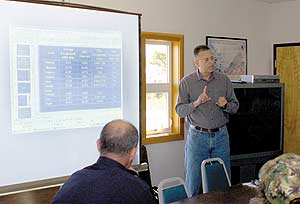|
www.theworldlink.com/articles/2007/03/22/breaking/tpn03032207.txt
ODFW, trollers
discuss fishery options
By Susan
Chambers,
March 22, 2007 The World
Link

|
|
Oregon Department of Fish and
Wildlife spokesman Ron Boyce
talks about fall Chinook
returns and commercial fishing
options for bubble fisheries
around some Oregon river
mouths in 2007. South Coast
trollers discussed experiences
of last year and options for
this year at a meeting at the
Charleston RV Park recreation
room on Wednesday. World Photo
by Madeline Steege |
CHARLESTON -
Oregon Department of Fish and
Wildlife officials heard plenty
from local salmon trollers
Wednesday regarding potential
state-waters fishing opportunity
later this year.
The overwhelming statement was
that state fisheries extend out to
the full three miles - not only 30
fathoms, as was the case in
several “bubble fisheries” around
local river mouths last year.
In the wake of a closed commercial
season last year, the department
designed bubble fisheries in state
waters that would target healthy
fall Chinook stocks returning to
specific rivers. Data suggested
that fishermen would have little
or no impact on the Klamath River
stock - the fish that limited the
federal season.
The only problem was that the
experiment didn't work quite as
expected. On Wednesday, the
department tracked comments from
fishermen at the Charleston RV
Park recreation room on exactly
what did - and didn't - work.
Some of the allowed areas to fish
were too small, too limited. A
weather anomaly, cold water that
settled in near several of the
rivers, pushed the fish offshore.
When salmon did venture near the
river mouths, most were intent on
getting upriver to spawn, passing
by fishermen's lures. Only a
handful of fish were caught in
state waters.
“It was an odd situation,”
Charleston troller Paul Merz said
of the colder water temperatures.
For many, it
also was frustrating because
commercial boats, limited to a
certain portion of state waters
within a 3-mile limit, watched as
sport fishermen zoomed past to 5
or 6 miles offshore and caught
their limits of Chinook.
That fact still rankled a few
trollers Wednesday.
When federal waters are closed to
commercials, sport boats also
should be limited to state waters,
J.D. Evanow, of Charleston, said.
“We need to pull them inside
3-mile waters,” he said. “We need
to collect data from those boats.”
That's not an
easy fix, said Ron Boyce, ODFW's
technical resources program
manager for the department's Ocean
Salmon and Columbia River
programs. Those kinds of issues
would have to be taken up through
the federal process.
However, noting trollers' concern,
ODFW staff accessed coded-wire tag
data, information used to get an
idea of the catch distribution.
The raw data, before being
extrapolated, showed that 8
percent of the coded-wire tag
returns in the sport sector were
from Klamath River fall Chinook.
The commercial sector, with all of
the fishing occurring north of
Florence, returned tags from
Klamath River fish of 5 percent.
Generally, Boyce said, both sport
and commercial sectors are
supportive of one another on the
South Coast. Fishermen agreed that
yes, there should also be sport
opportunity, but voiced their
frustrations at being tied to the
dock day after day and seeing
sport boat after sport boat return
with more fish.
Ocean Salmon sampling project
leader Eric Schindler said that
both sectors - sport and
commercial - are managed at the
federal level on their impacts on
specific runs of salmon.
“Historically, commercials take
about 10 times more (Klamath River
fall Chinook) than sports,”
Schindler said.
Boyce said that one option the
state is considering, after a
request made by the Oregon Salmon
Commission, would be to completely
open state waters to salmon
trolling from border to border, if
the federal fishery is closed.
Other options are for bubble
fisheries with expanded areas.
What is the enforcement
considerations of a 30-fathom
bubble vs. a 3-mile bubble,
troller Jeff Reeves asked.
Oregon State Police Sgt. David
Gifford said a 3-mile limit would
definitely be easier to enforce.
“The 30-fathom curve varies all
over,” Gifford said.
Several ideas for expanded areas
around the Siuslaw, Umpqua, Coos,
Elk, Rogue and Chetco rivers were
discussed, but most fishermen
agreed to skip the Rogue River
option altogether. The fish
generally aren't available during
the time a bubble fishery would be
allowed, trollers said, and the
bar at Gold Beach is
unpredictable.
Boyce said he would compile all
the comments and forward them and
a matrix of options to Oregon
Salmon Commission Administrator
Nancy Fitzpatrick so fishermen
could look them over and comment
before the Fish and Wildlife
Commission meeting on April 13 in
Salem.
Federal fisheries managers also
will be seeking public input on
three proposed for both sport and
commercial fishing in federal
waters. The Pacific Fishery
Management Council will decide in
April which options to choose.
Council representatives will
accept public input at a meeting
at 7 p.m. on Monday, March 26, at
the South Umpqua room of the Red
Lion Hotel in Coos Bay. |

